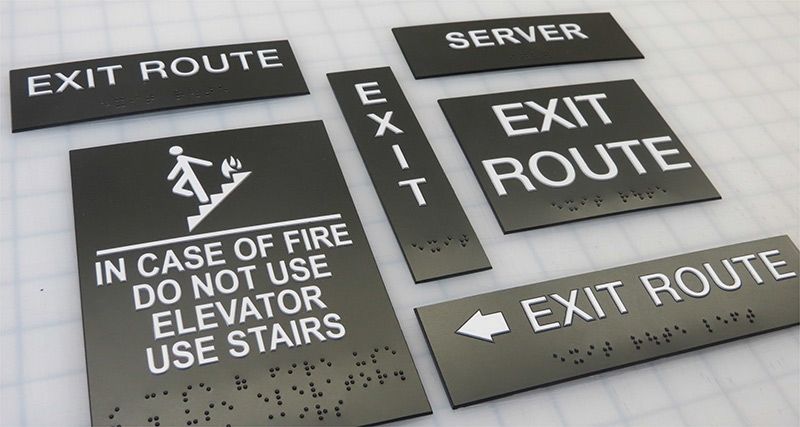ADA Signage: Ensuring Access and Compliance in Public Spaces
ADA signs plays a crucial role in assuring accessibility and conformity within public spaces, substantially contributing to an inclusive atmosphere for people with specials needs. By sticking to ADA criteria, signage not only assists in navigating but additionally highlights a company's dedication to variety and equality. As we check out the subtleties of ADA signage, from tactile features to create intricacies, it's important to think about just how these components coalesce to support the legal rights of all customers. What are the common mistakes companies encounter in keeping compliance, and how can future trends in signage proceed to drive availability onward?
Significance of ADA Signage
In modern culture, the value of ADA signage extends past plain conformity with legal mandates to embody a commitment to inclusivity and ease of access for all individuals. These indicators are essential in developing settings where individuals with specials needs can browse public areas with the same convenience and freedom as those without specials needs. By offering clear and standardized details, ADA signs guarantees that everyone can access centers, services, and information without obstacles.
The value of ADA signage hinges on its capacity to enhance the quality of life for individuals with disabilities by advertising equal gain access to. It gets rid of the obstacles that could otherwise hinder their capacity to participate completely in community life. These indications offer as visible signs of an organization's commitment to variety and equality, showing more comprehensive societal worths that promote the civil liberties and self-respect of all people.
Furthermore, ADA signs plays a vital role in public security. By assisting individuals to leaves, restrooms, and other crucial facilities, it makes sure that all people, no matter physical ability, can leave securely throughout emergencies. In summary, ADA signs is not just a governing need but a powerful device for cultivating a equitable and inclusive society.
Crucial Element of Conformity

Positioning is vital; indications need to be set up in places that are quickly visible and reachable. Usually, signage should be mounted in between 48 and 60 inches from the ground to make certain accessibility for both standing and wheelchair customers. Responsive aspects, such as Braille, are vital for individuals with visual problems, giving critical info in a non-visual format.
High-contrast shades in between the message and background are necessary to boost readability for people with low vision. The ADA mandates specific comparison ratios to ensure quality. Furthermore, character dimension is a crucial consideration, with minimum height needs dictated by the watching range to ensure readability from numerous angles.
Style Considerations for Accessibility
Creating easily accessible signage calls for a precise approach to guarantee it meets the demands of all individuals, particularly those with handicaps. This involves taking into consideration different layout elements that improve readability and use. Key variables include the selection of font, color comparison, and tactile attributes. Fonts must be sans-serif, with straightforward and clear letterforms, to help with easy reading. The dimension of the text is similarly critical, with ADA guidelines advising a minimum elevation based upon seeing range to make certain clarity.
Contrasting colors in between text and background are necessary for visibility, especially for people with aesthetic impairments. In addition, responsive components, such as Braille and elevated characters, are vital for individuals that are blind or have reduced vision.
Additionally, the placement of signage plays a substantial function in accessibility. Indications should be mounted in locations that are quickly obtainable and unobstructed. Making sure that signs is placed at appropriate elevations and angles allows all users, including those making use of mobility devices, to communicate with them efficiently.
Common Blunders to Avoid

Another common error is the inaccurate positioning of signage. ADA standards specify exact height and place needs to make sure that indicators are obtainable and conveniently noticeable by all people, including those making sites use of wheelchairs. Overlooking these standards not just hinders access but additionally risks non-compliance with legal standards.
Additionally, insufficient comparison in between message and background is visit this web-site a regular oversight. Adequate comparison is crucial for readability, especially for people with reduced vision. Designers sometimes choose colors that are aesthetically attractive but lack the needed comparison, providing the text tough to discern.
Finally, some designers stop working to integrate tactile aspects, such as Braille, which are important for people who are blind. Leaving out these functions not just causes non-compliance with ADA laws but also restricts access for a segment of the populace that depends on tactile information.
Future Trends in Signage
Developments in modern technology and raising awareness of inclusivity are forming the future patterns in signage layout. Digital signage, for circumstances, is developing to include interactive functions and real-time updates, which can be essential in giving vibrant info in public spaces.
One more emerging trend is the usage of augmented reality (AR) to improve user experience. AR-enabled signs can overlay digital information onto the physical environment, providing visually damaged individuals with auditory or haptic responses. ADA Signs. This technology not only boosts access however likewise develops an interesting experience for all customers
Sustainability is also a considerable aspect affecting signage patterns. Eco-friendly products and energy-efficient lights remedies are being focused on to line up with worldwide environmental goals. Furthermore, innovations in materials science are leading to the growth of even more long lasting and weather-resistant indications.
Verdict
ADA signage plays a vital role in ensuring availability and conformity within public rooms by including responsive elements, high-contrast colors, and tactical placement. The adherence to ADA criteria not only promotes risk-free navigating for people with specials needs yet additionally signifies an organization's dedication to diversity and inclusivity. By avoiding usual errors and accepting future web link patterns, public spaces can remain to progress these worths, making certain that the civil liberties and self-respect of all people are valued and maintained.
ADA signs plays an indispensable duty in assuring access and conformity within public areas, considerably adding to an inclusive environment for people with handicaps. As we check out the nuances of ADA signage, from responsive functions to create ins and outs, it's vital to think about how these components coalesce to copyright the civil liberties of all individuals.In contemporary culture, the value of ADA signage extends past plain compliance with legal requireds to embody a commitment to inclusivity and ease of access for all people. By supplying standard and clear info, ADA signs makes sure that everyone can access centers, services, and details without barriers.
ADA signs plays an important duty in ensuring accessibility and conformity within public spaces by incorporating responsive elements, high-contrast colors, and strategic placement. (ADA Signs)
Comments on “ADA Signs: Important Tools for Inclusive Environments”